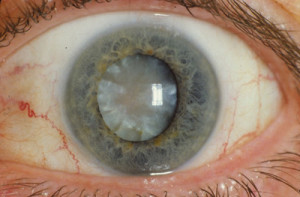Difference Between Glaucoma and Cataract
Glaucoma vs Cataract
Introduction
The eye is an inbuilt camera of the human body. Its various parts like the lens, retina (part on which the image falls), iris (coloured part of the eye) are subject to damage with progressing age. Some of these damages are termed Glaucoma and Cataract. Glaucoma is damage to the optic nerve, the main nerve of the eye, characterised by an increase in the pressure of the eyeball. Cataract is opacity or clouding of the lens of the eye. Both of these diseases present as loss or disturbances of vision.
Difference in causes
Glaucoma results from damage to the optic nerve due to various reasons which in turn causes a block in the flow of the aqueous humor in the eye. The aqueous humor is a fluid in the front chamber of the eye which usually flows through dedicated tubes and channels within the eye. When this normal movement is blocked, it causes a rise in the pressure in the eye and in turn damages the delicate fibres of the optic nerve. The most common risk factors of Glaucoma are age more than 45yrs, a family history of glaucoma (commonly passed from parent to child), Diabetes and Myopia (nearsightedness). Other causes could be injury or an eye infection.
In Cataract, the lens which focuses light or image on the retina becomes clouded due to the formation of protein clumps within it. This prevents light from passing to the retina. This is most of the times age related that is occurs in patients after 60 years of age or it could be congenital which means present at birth. The secondary causes of cataract are Diabetes, injury, certain drugs and radiation. It is also important to note that cigarette smoking and alcohol consumption hasten cataract formation.
Difference in manifestations
Glaucoma can affect both the eyes in varying degrees but unfortunately does not show symptoms in early stages. The common form of glaucoma presents at a later stage as a loss of the peripheral vision which may often go unnoticed by patients. So, it becomes very important for patients after the age of 45 or those with potential risk factors to go for regular eye checkups to diagnose it early in life. The rare form called closed angle or acute glaucoma, presents as sudden headache, nausea, vomiting and loss of vision. Glaucoma is detected after a careful eye examination and by measuring the intraocular eye pressure.
Cataract is a slow process of impairment of vision. Patients will usually complain of blurred, foggy vision, progressive nearsightedness or rings around bright objects manifested as frequent change in eyeglasses, changes in the way colours are seen, hindrance in night driving due to night glare and double vision. It is easily detected by an ophthalmologist by examining the eye with a special magnifying glass-like instrument called the ophthalmoscope.
Difference in treatment
The aim of glaucoma treatment is to slow down its progression by maintaining a normal eye pressure which can be managed by eye drops or oral medications. However at a later stage when symptoms worsen surgery may also be an option.
Cataract by rule requires surgery, the timing of which can be decided according to the severity of symptoms. If both the eyes require surgery, it can be performed at an interval of four to eight weeks as an outpatient procedure.
Summary:
Glaucoma and cataract, both are leading causes of blindness in many elderly. Cataract though a surgical disease presents with warning signs of impairment of vision. However, glaucoma is best treated by detecting it at an early stage and starting treatment to prevent it from progressing.
- Difference between near sightedness and far sightedness - January 21, 2015
- Difference between Diverticulosis and Diverticulitis - January 20, 2015
- Difference between Prilosec and Nexium - January 19, 2015
Search DifferenceBetween.net :
Leave a Response
References :
[0]http://www.aao.org/publications/eyenet/201204/images/Feature0_1.jpg

